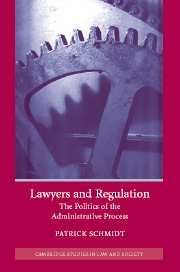Book contents
- Frontmatter
- Contents
- List of figures and tables
- Table of cases
- Acknowledgments
- List of abbreviations
- 1 Introduction
- 2 The contours of a regulatory bar
- 3 Administrative rulemaking
- 4 Rulemaking litigation
- 5 Enforcement
- 6 Regulatory counseling
- 7 Conclusion
- Appendix 1 Research methods
- Appendix 2 Survey instrument
- Notes
- Bibliography
- Index
Appendix 1 - Research methods
Published online by Cambridge University Press: 11 July 2009
- Frontmatter
- Contents
- List of figures and tables
- Table of cases
- Acknowledgments
- List of abbreviations
- 1 Introduction
- 2 The contours of a regulatory bar
- 3 Administrative rulemaking
- 4 Rulemaking litigation
- 5 Enforcement
- 6 Regulatory counseling
- 7 Conclusion
- Appendix 1 Research methods
- Appendix 2 Survey instrument
- Notes
- Bibliography
- Index
Summary
Researching lawyers' behavior presents substantial hurdles. Foremost is the attorney–client privilege, which prevents attorneys from discussing specific information about professional relationships with clients. Individual attorneys construe the privilege differently, preventing systematic collection of data. While scholars have been able to secure wider access in mainstream areas of the law, such as divorce proceedings, the heightened sensitivities of elite attorneys and their corporate clients present nearly insurmountable challenges. A second hurdle is that lawyers' accounts of their work can be tinged with self-serving defensiveness. This problem, perhaps a reaction to the popular bias that lawyering requires an ability to defend the indefensible and advocate half-truths, is compounded by lawyers' strong professional identity. In regulatory processes, parties tend to overstate the importance of their formal and net contributions to decisionmaking while denying (or refusing to acknowledge) their informal influences on decisionmakers. Some components of the “lawyers as friction” critique, such as ex parte communications, usually are intended to evade detection, and their full contribution to the process (if any) will never be appreciated. In order to surmount these obstacles, I actively employed multiple sources of data for the same set of questions. While methodological pluralism does not guarantee that the evidence is free of errors, it decreases the likelihood that the systematic biases of one approach will escape notice.
INTERVIEW DATA
Interviews with attorneys and other leading participants in the OSHA process provided the primary source of information about attorneys' roles in regulatory law.
- Type
- Chapter
- Information
- Lawyers and RegulationThe Politics of the Administrative Process, pp. 223 - 228Publisher: Cambridge University PressPrint publication year: 2005

